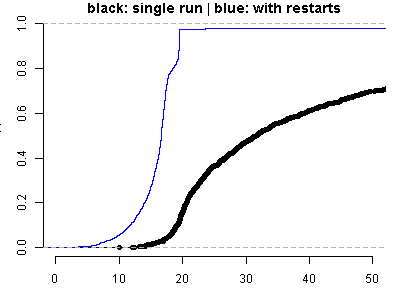Restarting Nelder-Mead
We describe a simple method to improve the results of Nelder–Mead direct search: instead of relying on a single run with possibly many iterations, we restart the search (ie, re-initialise the simplex) several times. While it is impossible to give advice like 'this is always better than that', the restart-strategy is easy to test; thus, for a given problem we can run little experiments to find out whether it should be used. Here is one such experiment.
We load and attach the NMOF package.
require("NMOF") ## attach the package
An example problem, the Rosenbrock function. The minimum is at x==1;
the minimum function value is zero.
OF <- tfRosenbrock ## see ?testFunctions size <- 20L ## the problem size x <- rep(1, size) ## the (known) solution OF(x) ## ... and associated OF value
[1] 0
How many steps would Nelder-Mead need to signal convergence? (Note that we do not require actual convergence; we just want to know after how many iterations the algorithm stops.) To find out, we run a little experiment.
iterStop <- numeric(1000L) for (i in seq(along.with = iterStop)) { x0 <- rnorm(size) sol <- optim(x0, OF, control = list(maxit = 1e6)) iterStop[i] <- sol$counts[1L] } summary(iterStop)
Min. 1st Qu. Median Mean 3rd Qu. Max. 3671 7638 9332 9782 11410 27500
The summary command should give a result like this (it will differ
because of the random starting values).
Now we try to minimise the Rosenbrock function. We test two strategies: strategy 1 uses a single restart with at most 25.000 function evaluations from a random initial solution. strategy 2 uses the same initial solution, but 4 additional restarts, each starting from the last returned solution. We set up strategy 2 such that it will, at most, use the same number of function evaluations as strategy 1.
trials <- 1000L res1 <- numeric(trials) ## results of strategy 1 res2 <- numeric(trials) ## results of strategy 2 for (i in seq_len(trials)) { ## random initial solution: same for type 1 and type 2 x0 <- rnorm(size) ## strategy 1 -- single run sol <- optim(x0, OF, control = list(maxit = 25000)) feval <- sol$count[1L] ## iterations needed res1[i] <- sol$value ## strategy 2 -- restart for (j in 1:5) { sol <- optim(x0, OF, control = list(maxit = trunc(feval/5))) x0 <- sol$par } res2[i]<- sol$value }
Finally, we plot the results.
par(mar = c(3,3,1,1), bty = "n") plot(ecdf(res1), xlim = c(0,50), ylim = c(0,1), main = "black: single run | blue: with restarts") lines(ecdf(res2), col = "blue")
